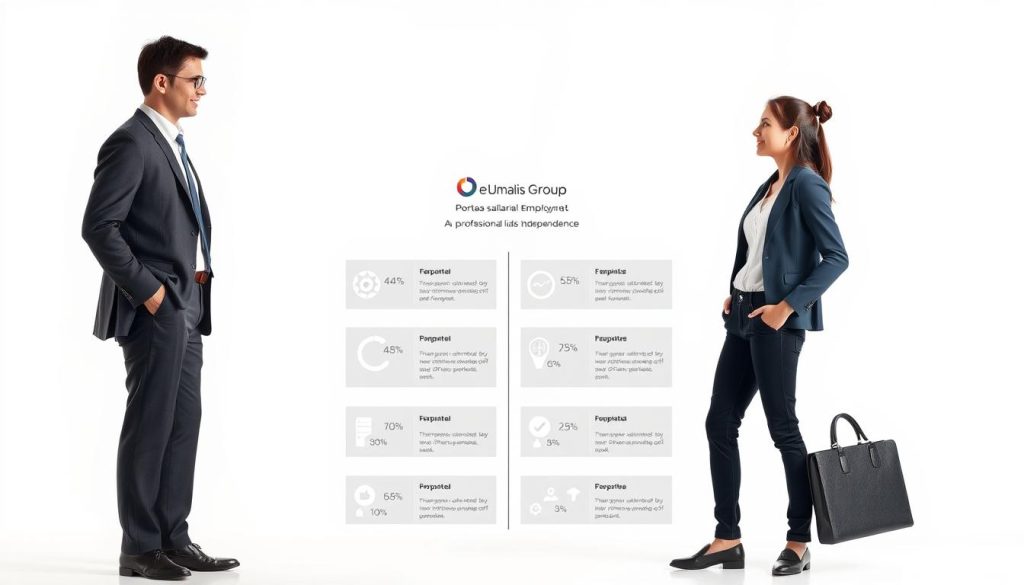Have you ever dreamed of working independently while still enjoying the security of traditional employment? Portage salarial offers a unique solution that bridges the gap between freelancing and salaried work. This innovative model empowers professionals to take control of their careers without sacrificing stability.
At its core, portage salarial involves a tripartite relationship. The consultant, known as the salarié porté, collaborates with a specialized entreprise de portage and the client company. This setup ensures that you can focus on delivering exceptional work while the administrative and legal aspects are handled for you.
This framework provides a secure and supportive environment, making it an ideal choice for those seeking professional independence. Whether you’re a seasoned consultant or exploring freelancing for the first time, understanding the legal and practical benefits of this model is essential.
In the sections ahead, we’ll dive deeper into how this system works, its advantages, and how you can leverage it to achieve your career goals. Let’s explore how portage salarial can be your pathway to freedom and security.
Table of Contents
Key Takeaways
- Combines the flexibility of freelancing with the security of traditional employment.
- Involves a tripartite relationship between the consultant, portage company, and client.
- Provides administrative and legal support, allowing you to focus on your work.
- Ideal for professionals seeking independence without compromising stability.
- Understanding the legal framework and benefits is crucial for success.
What Is Portage Salarial?
Looking for a way to balance independence with job security? Portage salarial might be the answer. This unique model combines the freedom of freelancing with the stability of traditional employment. It’s designed for professionals who want to take charge of their careers without losing essential protections.
At its core, this arrangement involves three key parties: the consultant, the entreprise portage, and the entreprise cliente. The consultant delivers specialized expertise to the client company. Meanwhile, the entreprise portage handles administrative tasks like contracts, payroll, and legal compliance. This setup allows you to focus on your work while enjoying the benefits of a salaried position.
The code travail provides the legal framework for this model. It ensures that all parties adhere to employment laws, protecting your rights as a consultant. This legal structure makes the arrangement secure and reliable for everyone involved.
Here’s a breakdown of the roles in this tripartite relationship:
| Party | Role |
|---|---|
| Consultant | Delivers expertise and services to the client. |
| Entreprise Portage | Manages administrative and legal tasks. |
| Entreprise Cliente | Benefits from specialized skills and services. |
This model is ideal for professionals who value independence but also want the security of traditional employment. By understanding the roles and legal framework, you can make the most of this innovative arrangement.
portage salarial définition: Understanding the Basics
Ever wondered how to maintain professional freedom while enjoying employee benefits? This model, originating in France, offers a unique solution. It combines the flexibility of freelancing with the security of traditional employment, creating a win-win scenario for professionals.
At its core, this arrangement involves a tripartite relationship. The consultant, the entreprise portage, and the client company work together seamlessly. The contrat travail between the société de portage and the salarié porté ensures clarity and legal protection for all parties.
One of the key benefits is the integration of sécurité sociale provisions. This ensures that consultants receive benefits like health insurance and paid leave. It’s a robust system that supports professionals while they focus on delivering exceptional work.
Historically, this model gained popularity in France as a response to the growing demand for flexible work arrangements. It has since become a preferred choice for skilled professionals in fields like IT and consulting. For a deeper dive into its origins, check out this definition of portage salarial.
Here’s a quick overview of how the system works:
| Component | Role |
|---|---|
| Consultant | Provides specialized expertise to the client. |
| Entreprise Portage | Handles administrative and legal tasks. |
| Client Company | Benefits from the consultant’s skills and services. |
This model is ideal for those who value autonomy but also want the stability of a robust social security system. By understanding its basics, you can make an informed decision about your career path.
Legal Framework and Contract Requirements
Navigating the legal aspects of professional independence can feel overwhelming. However, understanding the legal framework and contract requirements ensures a smooth and secure transition. This model provides a structured approach, allowing you to focus on your work while adhering to essential regulations.
Contract Duration and Renewal Conditions
Contracts in this arrangement are designed to offer flexibility while maintaining stability. Typically, they can be renewed up to two times, ensuring continuity for both the consultant and the client. This renewal process is straightforward, often requiring mutual agreement and a review of performance metrics.
Duration limits are also in place to protect all parties. For instance, contracts may have a maximum term of 18 months, with extensions granted under specific conditions. This balance ensures that the arrangement remains beneficial and legally compliant.
Mandatory Clauses and Legal Obligations
Every contract must include specific clauses to ensure clarity and protection. These include details on remuneration calculation, frais gestion, and the roles of each party. Such clauses provide transparency, helping you understand your rights and responsibilities.
Legal obligations are equally important. The code travail outlines the framework, ensuring compliance with employment laws. This includes provisions for social security, paid leave, and other benefits, making the arrangement secure for everyone involved.
Here are some examples of mandatory clauses:
- Clear terms of remuneration and frais gestion.
- Roles and responsibilities of the consultant, entreprise portage, and client.
- Conditions for contract renewal and termination.
By adhering to these requirements, you can ensure a legally sound and mutually beneficial arrangement. Understanding these details is essential for a successful and secure professional journey.
CDD and CDI Considerations
Are you exploring contract options that align with your professional goals? Understanding the differences between CDD (fixed-term contracts) and CDI (permanent contracts) is crucial for making informed decisions. Each contract type offers unique benefits tailored to specific career needs.
Contract Specifics for CDD
A CDD is ideal for short-term projects or temporary assignments. It has a predefined duration, typically ranging from a few months to a maximum of 18 months. Renewal is possible but limited to two extensions, ensuring flexibility while maintaining legal compliance.
Key features of a CDD include:
- Clear start and end dates for the contract.
- Renewal limits to prevent indefinite temporary work.
- Specific conditions for termination, protecting both the salarié and the entreprise.
Flexibility in CDI Arrangements
On the other hand, a CDI offers long-term stability and security. It’s designed for professionals seeking extended engagements with one or multiple clients. Unlike a CDD, there’s no fixed end date, providing continuous employment benefits.
Advantages of a CDI include:
- No renewal limits, ensuring ongoing professional relationships.
- Greater flexibility to work with multiple clients simultaneously.
- Access to comprehensive benefits like health insurance and paid leave.
Here’s a comparison of CDD and CDI:
| Aspect | CDD | CDI |
|---|---|---|
| Duration | Fixed-term (up to 18 months) | Indefinite |
| Renewal | Limited to two extensions | No renewal limits |
| Flexibility | Ideal for short-term projects | Suited for long-term engagements |
| Benefits | Limited to contract duration | Comprehensive and ongoing |
Choosing between a CDD and a CDI depends on your career goals. If you value short-term flexibility, a CDD might be the right fit. For long-term stability and growth, a CDI offers unmatched advantages.
« The right contract type can transform your professional journey, offering the balance of flexibility and security you need. »
By understanding these contract types, you can make a choice that aligns with your aspirations and ensures a fulfilling career path.
Analyzing Contract Clauses and Obligations
Understanding the fine print of your contrat is key to securing your professional independence. Contracts in this arrangement are designed to ensure clarity, transparency, and legal compliance. They outline the rights and responsibilities of all parties involved, providing a solid foundation for your work.
Every contrat must include specific clauses to protect your interests. These cover areas like remuneration, indemnity, and professional obligations. For instance, the remuneration clause details how your earnings are calculated, ensuring fairness and transparency.
Indemnity clauses are equally important. They address scenarios like indemnity d’apport d’affaire, ensuring you’re compensated for bringing business opportunities. This peut être a critical factor in ensuring clarity and fairness in your professional relationships.
Periodical reporting requirements are another essential aspect. These clauses ensure that all parties stay informed about project progress and financial matters. Regular updates help maintain trust and accountability throughout the engagement.
Here’s a breakdown of key clauses typically included:
- Remuneration: Details how your earnings are calculated and paid.
- Indemnity: Covers compensation for specific contributions or scenarios.
- Reporting: Outlines the frequency and format of progress updates.
Understanding these clauses is crucial for your professional journey. They ensure that your travail is protected and that you’re fully aware of your rights and responsibilities. For more insights, explore this guide on understanding professional contracts in France.
« A well-structured contract is your safety net, ensuring clarity and security in every professional engagement. »
By familiarizing yourself with these details, you can confidently navigate your career path. The legal framework ensures that your travail is secure, allowing you to focus on delivering exceptional results.
Roles and Relationships in the Tripartite Model
How does the tripartite model redefine professional independence? This innovative framework brings together three key players: the salarié porté, the entreprise portage, and the entreprise cliente. Each party has a distinct role, ensuring a seamless balance between autonomy and support.
Role of the Salarié Porté
The salarié porté is the heart of this model. As a professional, you bring your expertise and skills to deliver high-quality prestations to clients. Your autonomy allows you to manage your activité while focusing on what you do best—delivering results.
Key responsibilities include:
- Defining project scope and deliverables.
- Maintaining client relationships and ensuring satisfaction.
- Managing your time and resources effectively.
Function of the Entreprise Portage
The entreprise portage acts as your administrative backbone. They handle tasks like contracts, payroll, and legal compliance, freeing you to concentrate on your activité. This support ensures that you can work independently without the burden of paperwork.
Their key functions include:
- Managing contracts and ensuring legal compliance.
- Handling payroll and financial reporting.
- Providing access to social security and benefits.
Role of the Entreprise Cliente
The entreprise cliente benefits from your expertise while defining project goals and contractual terms. They rely on your skills to achieve their objectives, creating a mutually beneficial relationship.
Their responsibilities include:
- Defining project scope and deliverables.
- Providing necessary resources and support.
- Ensuring clear communication and collaboration.
Here’s a summary of the roles in the tripartite model:
| Party | Role |
|---|---|
| Salarié Porté | Delivers expertise and manages client relationships. |
| Entreprise Portage | Handles administrative and legal tasks. |
| Entreprise Cliente | Defines project scope and collaborates on deliverables. |
This model promotes a balance between independence and support, making it an ideal choice for professionals seeking stability and freedom. By understanding these roles, you can maximize the benefits of this innovative framework.
Benefits for Salariés Portés and Entreprise Portage
Are you seeking a professional framework that offers both independence and security? This model provides a unique blend of flexibility and stability, ensuring you can focus on your work while enjoying essential protections.
For salariés portés, the benefits are extensive. You’ll receive a minimum guaranteed salary, ensuring financial security even during slower periods. Additionally, you’ll have access to social benefits like health insurance, paid leave, and retirement plans. These protections are backed by the code travail, ensuring compliance with employment laws.
The entreprise portage also gains significant advantages. By managing multiple consultants efficiently, they streamline administrative tasks like payroll and legal compliance. This allows them to focus on providing top-notch support to their salariés portés.
Here’s a breakdown of the key benefits:
- Financial Security: A guaranteed minimum salary and transparent remuneration structure.
- Social Benefits: Access to health insurance, paid leave, and retirement plans.
- Legal Protections: Compliance with the code travail ensures your rights are safeguarded.
- Efficient Management: The entreprise portage handles administrative tasks, allowing you to focus on your work.
« This framework offers the perfect balance of independence and security, empowering professionals to thrive in their careers. »
By leveraging these benefits, you can achieve long-term stability and growth in your professional journey. The combination of financial security, social benefits, and legal protections makes this model an ideal choice for those seeking independence without compromising stability.
Financial Structures: Salary, Indemnity, and Reserve Funds
Understanding how your earnings are structured can make a big difference in your professional journey. In this framework, your income is calculated based on three key components: the base salary, indemnity for business acquisition, and financial reserves. This structure ensures transparency and fairness, giving you confidence in your financial arrangements.
The base salary is the foundation of your earnings. It’s determined by your expertise, the nature of your work, and the terms of your contract. Additionally, you may receive an indemnity for bringing business opportunities to the *société de portage*. This *indemnity d’apport d’affaire* rewards your efforts in securing new *missions*.
However, your net remuneration is impacted by certain deductions. *Frais gestion* and *frais professionnels* are subtracted to cover administrative and professional expenses. These fees are clearly outlined in your contract, ensuring there are no surprises.
Reserve funds are another critical aspect of this financial structure. These funds are set aside to compensate you during periods of *mission* downtime. They provide a safety net, ensuring financial stability even when projects are temporarily paused.
Here’s a breakdown of the financial components:
| Component | Purpose |
|---|---|
| Base Salary | Fixed income based on expertise and contract terms. |
| Indemnity | Reward for bringing business opportunities. |
| Reserve Funds | Financial safety net during project downtimes. |
« Transparency in financial structures builds trust and ensures long-term professional success. »
By understanding these components, you can make informed decisions about your career. This model prioritizes clarity and fairness, empowering you to focus on your work while enjoying financial security. For more insights, explore the benefits of this framework.
Tax, Social Security, and Fees Management

Managing taxes and fees can seem complex, but it doesn’t have to be. In this framework, financial transparency ensures you stay in control of your earnings. Let’s break down the key components: taxes, social security contributions, and management fees.
Tax implications are straightforward. Your salaire is subject to income tax, calculated based on your earnings. The entreprise portage handles tax filings, ensuring compliance with local regulations. This simplifies the process, allowing you to focus on your work.
Social security contributions safeguard your benefits. These include health insurance, paid leave, and retirement plans. The contributions are deducted from your salaire, ensuring you’re covered under the code travail. This system provides a safety net, offering peace of mind.
Management fees are another essential aspect. These cover administrative tasks like payroll and legal compliance. Typically, a monthly fee is deducted from your earnings. Here’s a breakdown of common fees:
| Fee Type | Purpose |
|---|---|
| Monthly Management Fee | Covers administrative and legal tasks. |
| Professional Expenses | Includes costs like training and equipment. |
For example, if your salaire is $5,000 per mois, a 10% management fee would deduct $500. This leaves you with $4,500, minus taxes and social security contributions. Understanding these calculations helps you plan your finances effectively.
Here’s a quick overview of the financial flow:
- Gross Salary: Your total earnings before deductions.
- Management Fees: Deducted for administrative support.
- Taxes and Contributions: Calculated based on net earnings.
- Net Salary: The amount you receive after all deductions.
« Financial transparency builds trust and ensures you’re always in control of your earnings. »
By understanding these components, you can navigate your financial obligations with confidence. This model prioritizes clarity, ensuring you’re fully informed about your salaire and deductions. For more insights, explore the tax advantages of this framework.
Operational Mechanics and Reporting Tools
How do operational tools and reporting systems enhance professional independence? These tools are essential for ensuring that both clients and consultants stay well-informed and aligned throughout their collaboration. They provide a structured approach to managing tasks, tracking progress, and maintaining transparency.
Monthly activity reports, known as CRA, play a crucial role in this framework. They document the work completed, hours spent, and fees allocated. This regular reporting ensures that all parties have a clear understanding of the project’s status and financial details.
Operational tools also facilitate the monitoring of work progress. They allow consultants to track their tasks, deadlines, and deliverables efficiently. These tools ensure that everyone stays on the same page, reducing misunderstandings and enhancing productivity.
Transparency is a key benefit of these mechanisms. The salarié porté, entreprise portage, and entreprise cliente can access real-time updates on project status and financials. This openness builds trust and fosters a collaborative environment.
Here’s how these tools support daily administrative tasks:
- Task Management: Organize and prioritize work efficiently.
- Financial Tracking: Monitor fees and expenses accurately.
- Communication: Facilitate clear and timely updates between all parties.
« Operational tools and reporting systems are the backbone of professional independence, ensuring clarity and efficiency in every project. »
By leveraging these tools, you can focus on delivering exceptional results while administrative tasks are handled seamlessly. This model prioritizes sécurité and efficiency, empowering you to thrive in your professional journey. For more insights, explore the benefits of this framework.
Sector-specific Regulations and Exceptions
Navigating sector-specific regulations ensures compliance and protects your professional independence. Certain industries have unique rules that determine whether this framework is permitted or excluded. Understanding these regulations is essential for maintaining legal compliance and safeguarding your career.
For example, sectors like services to persons—such as child care and elderly assistance—are often excluded. Legal stipulations in these fields require direct employment relationships, making this model incompatible. Similarly, regulated professions like medical and legal services may have restrictions based on licensing and ethical guidelines.
However, exceptions exist under specific conditions. In some cases, professionals in regulated sectors can participate if they meet certain criteria, such as holding the necessary licenses or certifications. These exceptions ensure that the framework remains flexible while adhering to industry standards.
Here’s a breakdown of sectors and their compatibility:
| Sector | Compatibility |
|---|---|
| IT and Consulting | Permitted |
| Child Care | Excluded |
| Medical Services | Restricted (with exceptions) |
These regulations protect both the consultant and the entreprise cliente. By ensuring compliance, they create a secure environment for collaboration. Clear sector-specific rules also prevent misunderstandings and legal disputes.
« Understanding sector-specific regulations is the key to maintaining compliance and achieving long-term professional success. »
Clarity about these rules is crucial. Always review your contract and consult with legal experts to ensure you’re adhering to industry standards. This approach not only protects your rights but also enhances your professional reputation.
Strategic Advantages for Consultants and Freelancers
What if you could enjoy the freedom of freelancing while maintaining the stability of traditional employment? This model offers exactly that, empowering professionals to take control of their careers. It’s a strategic choice for those seeking independence without sacrificing essential support.
One of the key benefits is the ability to manage multiple client relationships simultaneously. This flexibility allows you to diversify your income streams and expand your professional network. By working directly with clients, you can build stronger connections and enhance your business development opportunities.
The role of the entreprise de portage is crucial in this setup. They handle administrative tasks like contracts, payroll, and legal compliance. This support frees you to focus on delivering high-quality work, ensuring your personneal and professional growth.
Here’s how this model benefits consultants and freelancers:
- Career Flexibility: Choose projects that align with your expertise and interests.
- Client Access: Build direct relationships with multiple clients for greater opportunities.
- Administrative Support: Let the entreprise handle paperwork, so you can focus on your work.
Long-term advantages include a broader clientele and increased market exposure. This framework not only supports your current goals but also sets the stage for sustained professional success. For more insights, explore how this model can simplify your career journey.
« This framework combines the best of both worlds—freedom and security—empowering you to thrive in your career. »
By leveraging these strategic advantages, you can achieve a fulfilling and prosperous professional path. The blend of independence and support makes this model an ideal choice for modern professionals.
Implementing Portage Salarial in Your Career
Ready to take the leap into professional independence while maintaining stability? This model offers a structured path to achieving your career goals. Here’s how you can transition smoothly and confidently.
Start by identifying a reputable société de portage. These companies specialize in handling administrative tasks, allowing you to focus on your work. They’ll guide you through the process of signing a contract and starting your first mission.
Once you’ve chosen a société de portage, the next step is negotiating your contract. Pay close attention to clauses related to indemnité and other financial considerations. These details ensure transparency and fairness in your earnings.
Here’s a breakdown of the onboarding process:
- Contract Signing: Review terms, including indemnité and management fees.
- Mission Start: Begin your project with clear deliverables and timelines.
- Ongoing Support: Access guidance from your société de portage throughout the engagement.
Financial considerations are a key part of this transition. Your statut ensures you receive a guaranteed minimum salary, even during slower periods. Additionally, you’ll benefit from social security provisions, including health insurance and paid leave.
Here’s how the financial structure works:
| Component | Purpose |
|---|---|
| Base Salary | Fixed income based on expertise and contract terms. |
| Indemnité | Reward for bringing business opportunities. |
| Reserve Funds | Financial safety net during project downtimes. |
Support from established sociétés de portage is invaluable. They handle administrative tasks like payroll and legal compliance, freeing you to focus on your work. This support ensures a seamless transition to professional independence.
« This framework offers the perfect balance of independence and security, empowering professionals to thrive in their careers. »
By following these steps, you can confidently transition to this model. It’s a secure and supportive path to achieving your professional goals. For more insights, explore the benefits of this framework.
Real-World Examples and Success Stories
Discover how professionals are transforming their careers with a model that blends independence and security. Real-world examples illustrate the practicality and benefits of this approach, offering insights into its success.
Take the case of Sarah, a consultant in the IT sector. She transitioned to this framework and experienced remarkable career stability. The contractual disposition ensured she had a steady income while maintaining flexibility. This allowed her to focus on delivering high-quality work without administrative burdens.
Another success story comes from John, a professional in a cadre position. By leveraging this model, he enhanced his career trajectory. The tripartite relationship provided him with the support needed to excel in his field. John’s story highlights how this framework fosters positive professional connections.
Here are key takeaways from these success stories:
- Career Stability: Contractual dispositions ensure financial security.
- Professional Growth: Professionals in cadre positions can advance their careers.
- Strong Relationships: The tripartite relationship builds trust and collaboration.
« This framework gave me the freedom to focus on my work while enjoying the security of traditional employment. » – Sarah, IT Consultant
These real-world examples demonstrate the strength of this model. Whether you’re a consultant or in a cadre role, the benefits are clear. It’s a strategic choice for those seeking independence without compromising stability.
Comparative Analysis: Portage Salarial vs. Traditional Employment

What if you could have the best of both worlds—freedom and security—in your professional life? This model offers a unique blend of autonomy and stability, making it a compelling alternative to traditional employment. Let’s explore how these two frameworks compare in terms of flexibility, daily routines, and financial outcomes.
In traditional employment, your jour is often structured around fixed schedules and company policies. While this provides stability, it limits your ability to manage your time and projects independently. In contrast, this model grants you the freedom to choose your projects and set your own pace, empowering you to take control of your career.
When it comes to daily work routines, the differences are significant. As a salarié porté doit, you have the flexibility to work with multiple clients, diversifying your income streams. Traditional employment, on the other hand, ties you to a single employer, limiting your opportunities for growth and exploration.
Financially, this model offers unique advantages. Your revenu is calculated based on your expertise and the projects you undertake. Additionally, you may receive indemnities for bringing business opportunities, enhancing your earning potential. Traditional employment provides a fixed salary, but often lacks these additional incentives.
Here’s a quick comparison of the two models:
| Aspect | Portage Salarial | Traditional Employment |
|---|---|---|
| Flexibility | High | Low |
| Income Potential | Variable (with indemnities) | Fixed |
| Work-Life Balance | Self-managed | Company-driven |
Contractual and operational differences also play a role. This model ensures that administrative tasks are handled for you, allowing you to focus on your work. Traditional employment requires you to navigate company hierarchies and policies, which can be restrictive.
« This framework combines the best of both worlds—freedom and security—empowering you to thrive in your career. »
By understanding these differences, you can make an informed decision about your professional path. Whether you value independence or stability, this model offers a balanced solution that supports your goals.
Conclusion
Balancing independence with stability has never been easier. This model offers a transformative approach to professional growth, combining the freedom of freelancing with the security of traditional employment. With a well-structured contractual relationship, you gain access to essential benefits like health insurance and paid leave, ensuring peace of mind.
The seamless integration between independent work and administrative support from a reputable société de portage allows you to focus on what you do best. This framework not only empowers professionals but also adds significant value for entreprises clientes, fostering strong, collaborative partnerships.
Take the next step in your career journey. Explore how this model can provide the stability and flexibility you need to thrive. With the right support, you can achieve your goals while maintaining control over your compte and professional future.
FAQ
What is portage salarial?
Portage salarial is a professional framework that allows independent consultants to work under a formal employment contract while maintaining their autonomy. It bridges the gap between freelancing and traditional employment.
How does the tripartite model work in portage salarial?
The tripartite model involves three parties: the salarié porté (consultant), the entreprise portage (employment agency), and the entreprise cliente (client). The entreprise portage handles contracts, payroll, and administrative tasks, while the consultant focuses on delivering services to the client.
What are the benefits of portage salarial for consultants?
Consultants gain access to employment benefits like social security, retirement plans, and paid leave, while retaining the flexibility and independence of freelancing. It also simplifies administrative tasks and ensures compliance with legal requirements.
What types of contracts are available in portage salarial?
Consultants can choose between CDD (fixed-term) and CDI (permanent) contracts. CDD offers flexibility for short-term projects, while CDI provides long-term stability and security.
How are salaries and fees managed in portage salarial?
The entreprise portage deducts management fees and social security contributions from the consultant’s revenue. The remaining amount is paid as a salary, ensuring compliance with tax and labor laws.
What legal obligations must be included in a portage salarial contract?
Contracts must specify the duration, renewal conditions, scope of work, and financial terms. They must also comply with labor laws, including provisions for indemnities and reserve funds.
Can portage salarial be used in all industries?
While it’s widely applicable, certain sectors may have specific regulations or exceptions. It’s essential to verify industry-specific rules before opting for this model.
How does portage salarial compare to traditional employment?
Portage salarial offers greater flexibility and autonomy compared to traditional employment, while still providing employment benefits. It’s ideal for professionals seeking a balance between independence and security.
What tools are used for reporting and managing portage salarial activities?
Entreprises portage often provide digital platforms for time tracking, invoicing, and reporting. These tools streamline administrative tasks and ensure transparency in financial and operational management.
How can I implement portage salarial in my career?
Start by researching reputable entreprises portage, understanding contract terms, and aligning the model with your professional goals. It’s a strategic step toward securing independence while maintaining stability.





